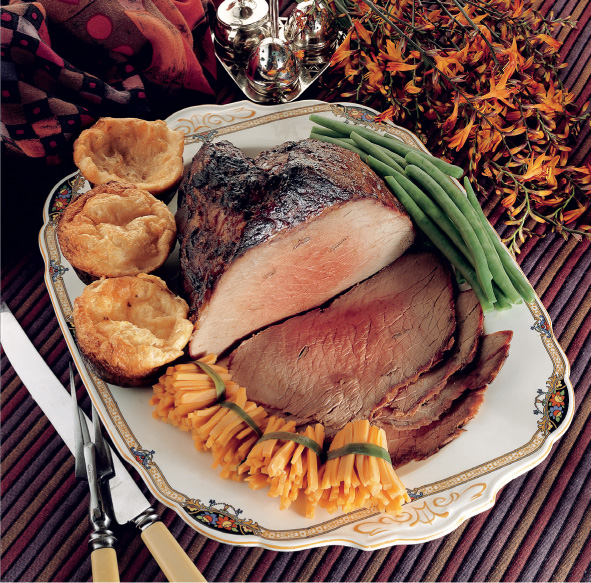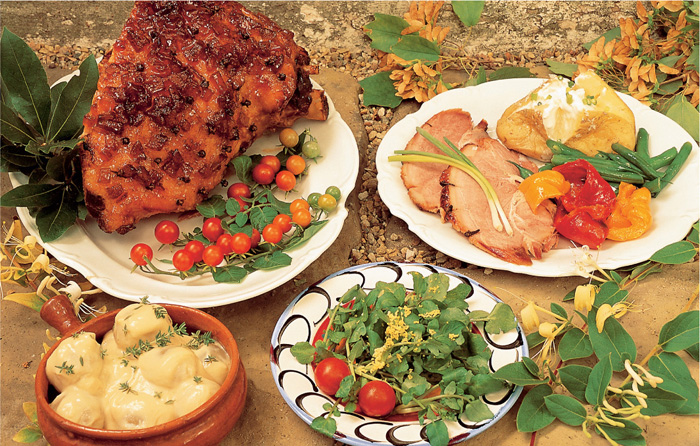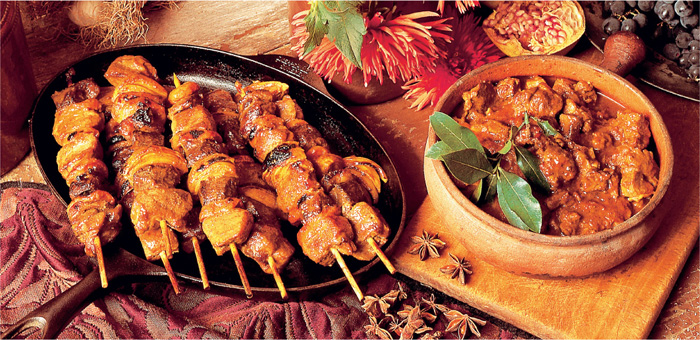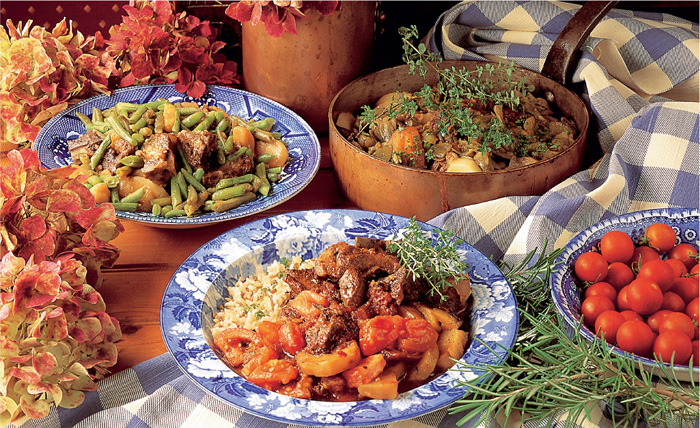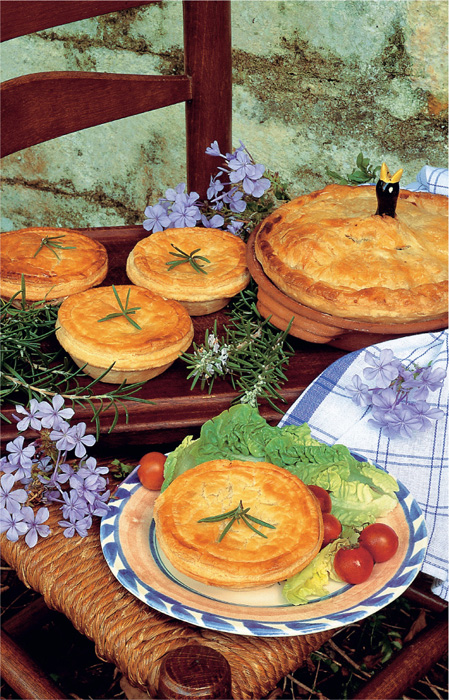MEAT
There was already an abundance of beef at the Cape when the early settlers arrived, but the meat tended to be tough because the animals, having to range far and wide in search of food, developed muscle in the process. The fat-tailed sheep, however, provided flavourful mutton as a result of the veld bushes they fed on. There were plenty of wild animals and birds that yielded good meat and these were part of the daily diet from the start. Wild animals also formed a major part of the diet of those who trekked beyond the borders of the Cape Colony in later times, and many recipes for potjiekos stem from their experience (see Chapter 5). Pork and poultry were introduced by the colonists. Today the best mutton and lamb come from the Karoo or the grasslands of KwaZulu-Natal and the Free State. Many old recipes – those for bredies, for instance – call for fat mutton, but in our health-conscious era, less fatty lamb is preferred and mutton is not all that easy to find.
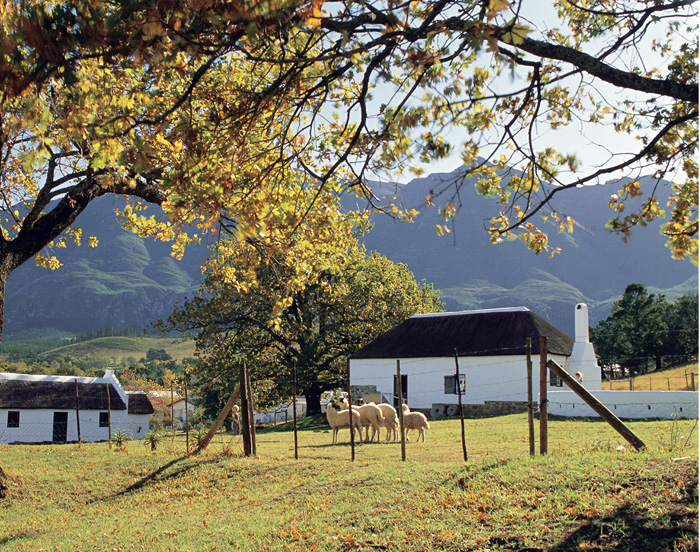
ROAST BEEF
The well-known ‘roast beef of England’ was once, for many South Africans, the only meat to serve as the main meal on Sundays. At some country hotels you will still find that the main course at the main meal of the day, even during the week, is a roast.
- 1.5–2 kg beef for roasting
- 1 clove garlic, halved
- 10 ml salt
- freshly milled black pepper
- 30 ml dripping
- Preheat the oven to 220 °C. Wipe the beef, rub with cut garlic, season and place in a roasting pan with the dripping. Roast for 15 minutes, reduce the temperature to 190 °C and continue roasting for 15 minutes per 500 g for rare beef and 20 minutes per 500 g for medium rare. Remove the roast from the pan and set it aside to rest in the warming oven while you make the Meat Gravy (page 43) and Yorkshire Pudding (page 43). Carve the meat and serve with roast potatoes, gravy and Yorkshire pudding.
Serves 6
FRIKKADELS (FRIKKADELLE)
Frikkadels, extremely popular in Holland in the 17th and 18th centuries, were introduced here by the Dutch settlers. In some form or other they remain favourites in many countries.
- 45 ml butter, margarine or sunflower oil
- 1 medium onion, minced or very finely chopped
- 750 g lean minced beef
- 1 thick slice crustless white bread, soaked in water and squeezed dry
- 2 large eggs
- 5 ml salt
- 1 ml milled pepper
- 1 ml ground allspice
- Heat 15 ml of the butter, margarine or oil in a large frying pan and sauté the onion in it for about 5 minutes, or until transparent. Combine the onion with the mince, bread, eggs, salt, pepper and allspice, and shape into balls. Heat the remaining butter, margarine or oil in the frying pan, and brown the frikkadels, a few at a time, for about 5 minutes on one side. Turn them over and brown the other side, then turn down the heat slightly and continue cooking the frikkadels for about 10 minutes, or until cooked through. Serve hot with mashed potatoes and an onion and tomato sauce.
- MICROWAVE OVEN Frikkadels microwave very well, and turn brown during the standing time. Arrange half the frikkadels in a circle in a glass pie dish, cover them loosely with waxed paper and microwave at 100 percent power for 9–12 minutes. Leave to stand while microwaving the remaining frikkadels.
Serves 6–8
YORKSHIRE PUDDING
This is the traditional accompaniment to roast beef, and cooks claim that there is an art to making it correctly so that it does not first rise too much and then fall flat when taken from the oven. The secret is to make it while the meat is resting and to serve it immediately.
- 125 g bread flour
- pinch of salt
- 1 large egg
- 150 ml milk
- 150 ml water
- 25 ml hot dripping from roast
- Sift the flour and salt into a mixing bowl and make a well in the centre. Break the egg into the well and add the milk. Using an electric beater and mixing from the centre, gradually incorporate the flour into the liquid. Add a little water and beat until the batter is smooth and shiny. Stir in the remaining water. Spoon a little dripping into each cup of a patty pan. Heat until the dripping is smoking hot. Fill each cup with batter and bake the puddings on the top shelf of the oven at 200 °C for about 25 minutes, or until golden brown and well risen. Serve at once with the roast.
Serves 4–6
MEAT GRAVY
Gravies are generally made from pan scrapings and meat juices, mixed with water, thickening and seasoning. This applies to all kinds of meat.
- dripping (fat and pan juices) from roast meat
- 15 ml cake flour
- 500 ml water
- salt and milled pepper (optional)
- Drain almost all the dripping from the roasting pan once the roast has been removed, leaving about 30 ml. Stir in the flour and cook the mixture gently over low heat until the flour is lightly browned. Remove from the stove and gradually blend in the water. When the mixture is smooth, return it to the stove and bring it to the boil, stirring. Add salt and pepper, if necessary, and pour the gravy into a gravy boat for serving.
Makes about 500 ml
CABBAGE FRIKKADELS (KOOLFRIKKADELLE)
These frikkadels, Malay in origin, are wrapped in blanched cabbage leaves and braised.
- 2 large onions, sliced
- 5 ml white sugar
- butter, margarine or oil
- 2 cloves garlic, crushed
- 2 ml ground ginger
- 4 cardamom seeds, crushed
- 4 whole cloves
- 4 allspice berries
- 1 stick cinnamon, broken into pieces
- 3 large, ripe tomatoes, skinned and chopped
- 1 quantity Frikkadels (page 42)
- 1 large cabbage
- Sauté the onions and sugar in heated butter, margarine or oil for about 5 minutes, or until transparent. With the saucepan still on the stove, add the garlic, ginger, cardamom seeds, cloves, allspice and cinnamon, and top with the tomatoes. Switch off the stove and set the mixture aside. Prepare the frikkadels as instructed in the recipe on page 42, but do not cook them. Meanwhile, remove the cabbage leaves from the head, wash well and place in a large dish. Pour boiling water over the leaves and leave them for a few minutes, until they are slightly softened but still crisp. Drain in a colander. Wrap each frikkadel in a cabbage leaf and pack them into the saucepan, on top of the onion and tomato mixture, with the seam side underneath. Switch on the stove and braise the frikkadels very slowly over low heat for about 45 minutes, or until the cabbage and meat are cooked and the onion and tomato mixture is delicately browned and cooked. Take care not to let the onions burn. Serve with cooked rice.
- VARIATION Instead of cabbage leaves, try this traditional recipe. Blanch young and tender vine leaves in boiling water until softened and securely wrap smaller quantities of the frikkadel mixture in them. Continue as described in the recipe.
Serves 6–8
COTTAGE PIE
Also called Shepherd’s pie, this British dish has been a favourite way of using up leftover meat for countless generations.
- 30 ml sunflower oil
- 1 medium onion, finely chopped
- 350 g beef mince or minced leftover meat
- 2 medium ripe tomatoes, skinned and coarsely chopped
- 5 ml dried mixed herbs
- salt and milled pepper
- 150 ml Meat (Beef) Stock (page 11)
- 500 g mashed potatoes
- 15 ml butter or margarine
- Heat the oil and sauté the onion for approximately 5 minutes, or until transparent. If you are using uncooked beef mince, add it to the pan and brown it quickly on all sides. (If using cooked meat, add it after the tomatoes.) Add the Tomatoes and heat for about 3 minutes. Add the mixed herbs, salt, pepper and stock, stirring well. Place the meat mixture in a deep casserole and cover with the mashed potatoes. Dot the butter or margarine on top and bake the pie in the centre of the oven at 180 °C for approximately 40 minutes, or until it is crisp and brown on top. Serve with peas and butternut squash.
Serves 4
BRAAIED PORK SPARERIBS
Spareribs have become a popular item on the menus of many South African restaurants, but they are also delicious cooked over the coals for a family braai.
- 1.5 kg pork spareribs, washed and trimmed
MARINADE
- 125 ml soy sauce
- 25 ml honey
- 15 ml sherry
- 1 clove garlic, crushed
- Place the spareribs in a shallow baking dish. Combine the ingredients for the marinade and pour over the ribs. Marinate for 2 hours, turning once. Drain, reserving the marinade. Braai the spareribs over moderate coals for 25–30 minutes, turning and basting often with the reserved marinade.
- VARIATION Grill the marinated spareribs under a preheated grill for about 20 minutes, turning and basting often with the marinade.
Serves 6
SPIT-ROAST LAMB
An ox spit-roast over the coals was once the fare for a large gathering, and is still a custom in some parts of the country. This modern adaptation uses lamb, which takes much less time to cook.
- about 16 kg lamb salt and milled pepper
BASTING SAUCE
- 500 ml sunflower oil
- 100 ml lemon juice
- 3 cloves garlic, crushed
- 25 ml chopped fresh thyme
- 10 ml chopped fresh oregano
- 10 ml chopped fresh rosemary
- Cut the lamb carcass open and spear it on the spit. Season the cavity with salt and pepper. Combine all the ingredients for the basting sauce. Braai the lamb over hot coals for 31⁄2–4 hours, or until done, basting often with the sauce.
- NOTES
- If you do not have a spit braai, turn and baste the lamb often while it is cooking.
- As a spit takes a long time to braai, make a second fire to supply hot coals when needed.
Serves 20–30
BOBOTIE
The dish we know today as bobotie was popular in Europe in the Middle Ages, after the Crusaders introduced turmeric from the East. Bobotie was traditionally made with meat left over from the Sunday roast.
- 1 slice white bread
- 250 ml milk
- 1 kg lean minced beef or mutton
- 1 medium onion, peeled and finely chopped
- 125 ml seedless raisins
- 125 ml blanched almonds
- 15 ml smooth apricot jam
- 15 ml fruit chutney
- 25 ml lemon juice
- 5 ml chopped fresh mixed herbs
- 10 ml curry powder
- 5 ml turmeric
- 10 ml salt
- 10 ml sunflower oil
- 3 large eggs
- 4 bay or lemon leaves
- Soak the bread in 125 ml milk, then squeeze it dry and reserve the milk. Mix the bread with the minced beef or mutton. Mix in all the other ingredients, except the remaining and reserved milk, the oil, eggs and bay or lemon leaves. Heat the oil in a frying pan and brown the meat mixture lightly. Turn it out into a casserole. Beat the eggs with the remaining and reserved milk, and pour the mixture over the meat. Garnish the top of the mixture with the bay or lemon leaves and bake at 180 °C for approximately 50 minutes, or until set. Serve with Yellow Rice with Raisins (page 72).
Pannas
In the early days at the Cape, the colonists made a kind of blood pudding, called pannas, from the lightly fried liver and kidneys of a pig. Tamarind water was added to sour it, and it was covered with fat before baking. To lengthen the storage time, it was covered with melted butter. The settlers served it sliced and fried in fat. It is still made today in some regions, most notably in Calvinia.
Serves 6–8
BAKED HAM
Baked, glazed ham has always had a pride of place on the Christmas dinner table, and it is certainly one of the easiest, and tastiest, treats at this time of year.
- 5 kg cured ham or gammon
- 5 ml mustard powder
- 10 ml ground ginger
- 1 bay leaf
- 5 peppercorns
- 500 ml Vegetable Stock (page 12) or water
GLAZE
- 250 ml apricot juice
- 25 ml lemon juice
- 25 ml ginger syrup
- 25 ml honey
- 125 ml finely chopped preserved ginger
GARNISH
- 10 cloves
- 410 g can apricot halves, drained
- 410 g can stoned cherries, drained
- Dust the ham or gammon with mustard powder and ground ginger. Place, fat side up, in a roasting pan. Add the bay leaf and peppercorns and pour the stock or water over the meat. Cover tightly with a lid or aluminium foil and bake at 160 °C for 3–31⁄2 hours. Remove the ham from the oven and discard the stock. Peel the skin off the ham, leaving the layer of fat intact. Score the fat with criss-cross cuts to form a diamond pattern. Mix all the ingredients for the glaze together and spoon the mixture over the ham. Bake for a further 10 minutes at 200 °C. To garnish, stud the ham with cloves and top with apricots and cherries. Keep warm until ready to serve.
Serves 20
ROAST SUCKING PIG
Our ancestors roasted sucking pigs on a spit over the open fire. This recipe is for oven roasting.
- 1 sucking pig
- 25 ml salt
- 10 ml milled pepper
- 250 g butter or fat
- 500 ml boiling water
- 2 large apples
- honey mixed with ground ginger, or smooth apricot jam mixed with brown sugar
- Clean and weigh the pig. Calculate 50 minutes roasting time per 500 g meat. Make 4 skin-deep incisions, each about 7 cm long, on either side of and at right angles to the backbone. Place the pig on the rack of a roasting pan and rub it with salt, pepper and butter or fat. Place an apple in the pig’s mouth. Add the boiling water and cover the pig with foil, adding an extra layer over the ears and feet to prevent burning or overcooking. Roast at 230 °C for 15 minutes, then lower the temperature to 150 °C and continue roasting the pig for the calculated time. (The meat is done when the internal temperature reads 100 °C on a meat thermometer.) Remove the foil after 21⁄2 hours and spread the honey and ginger or apricot jam and brown sugar over the skin. Roast, uncovered, for the rest of the roasting time. Serve it whole on a platter, with a fresh apple in its mouth.
- VARIATION To braai on a spit, cover the nose, ears and feet with foil and baste the pig often with a mixture of water, oil and herbs of your choice as it braais.
Serves 20–30
ROAST LEG OF LAMB
- 50 ml fresh white breadcrumbs
- 50 ml softened butter
- juice and grated rind of 1 lemon
- 3 cloves garlic, crushed
- 10 ml chopped fresh rosemary
- 2.5–3 kg leg of lamb
- salt and pepper to taste
- Combine the breadcrumbs, butter, lemon juice and rind, garlic and rosemary. Sprinkle the lamb with salt and pepper, and spread the breadcrumb mixture over it. Place on a rack in a roasting pan and cover loosely with foil. Roast at 180 °C for 25 minutes per 500 g meat. Remove the foil and roast for a further 15 minutes. Serve sliced, with rice or roast potatoes.
Serves 6
DENNINGVLEIS
Goat’s meat was often used in spicy stews like this one. The Malay name means ‘flavoured meat’.
- 15 ml dripping or sunflower oil
- 2 cloves garlic, crushed
- 2 large onions, sliced
- 10 ml white sugar
- 1 kg mutton rib or stewing mutton
- 4 whole cloves
- 4 allspice berries
- 2 bay or lemon leaves
- salt and pepper to taste
- 2 ml freshly grated nutmeg
- 125 ml water
- 2 ml tamarind seeds soaked in 125 ml water
- Heat the dripping or oil in a large saucepan and sauté the garlic, onions and sugar for about 5 minutes, or until the onions are transparent. Remove the mixture from the saucepan and set aside. Cube the meat and brown the pieces in the same saucepan. Add the onion mixture, the cloves, allspice, bay or lemon leaves, salt, pepper, nutmeg and water. Simmer, covered, for 11⁄2 hours, or until the meat is tender. Strain the tamarind water and discard the seeds. Add the tamarind water (or vinegar or lemon juice, see note below) to the stew. Simmer for another 15 minutes. Serve with boiled potatoes.
- NOTES
- Tamarind seeds impart a slightly sour flavour. They are available from specialist spice shops. If you can’t get them, use 50 ml brown vinegar or lemon juice instead.
- Goat’s meat is similar to mutton, but it is more strongly flavoured.
Serves 6
LAMB CURRY
Our ancestors would have used mutton to make a curry, but modern awareness of more healthy eating has swung the focus away from fatty mutton to leaner lamb. The combination of sweet and savoury – achieved by adding dried peaches, apricots, or raisins – in dishes like curries and Bobotie (page 45), is peculiarly South African, a legacy of the Malay cooks who adapted oriental recipes and used local ingredients to create a new culinary tradition.
- 25 ml sunflower oil
- 2 large onions, finely chopped
- 1 bay leaf
- 2 ml ground cinnamon
- 5 ml ground coriander
- 2 ml ground cumin
- 2 cloves garlic crushed
- 20 ml curry powder
- 25 ml cake flour
- 5 ml turmeric
- 1.5 kg lamb rib, trimmed of excess fat and cubed
- 500 g medium tomatoes, skinned and chopped
- 6–8 dried peaches or apricots, finely chopped
- 30 ml Fruit Chutney (page 136)
- 250 ml Meat (Beef) Stock (page 11)
- 5 ml white sugar
- 10 ml salt
- milled black pepper
- Heat the oil in a large saucepan and sauté the onions for about 5 minutes, or until transparent. Add the bay leaf, cinnamon, coriander, cumin, garlic, curry powder, flour and turmeric, and simmer for a few minutes, stirring constantly. Add the meat and brown it lightly, adding a little more oil if necessary. Add the remaining ingredients and mix well. Simmer over moderate heat for 1 hour. Serve immediately with boiled rice and bowls of sliced banana, desiccated coconut, diced pineapple and chutney.
- VARIATION Use mutton instead of lamb.
Serves 6
SOSATIES
Sosaties – skewered meat marinated in a curry sauce – formed part of the rijsttafel of Java, an elaborate banquet which always included at least two meat dishes, one fish course and a curry dish, as well as several vegetables, served on cooked rice and mixed with a strong curry sauce. Today we tend to cook sosaties over the coals, and any braai cook worth his or her salt has a ‘secret recipe’ for the marinade.
MARINADE
- 75 ml smooth apricot jam
- 25 ml brown sugar
- 3 cloves garlic, crushed
- 15 ml cornflour
- 2 bay or lemon leaves
- 25 ml curry powder
- 25 ml wine vinegar
- 10 ml salt
- 5 ml milled pepper
SOSATIES
- 3 medium onions, quartered
- 1.5 kg leg of lamb, cubed
- 1 kg pork, cubed
- 250 g dried apricots
- 125 ml cubed mutton fat
- Combine all the ingredients for the marinade in a saucepan and add the onion quarters. Bring to the boil and boil for 5 minutes, or until slightly thickened, stirring occasionally. Transfer the marinade to a large dish. Add the lamb and pork cubes and marinate them for 4 hours (or overnight) in a cool place, turning them 2–3 times. Soak the apricots in water to cover until plump, then drain. Remove the meat from the marinade and thread it into skewers alternatively with the mutton fat, apricots and onion. Braai the sosaties over moderate coals, or grill in the oven, turning frequently, for 25 minutes, or until cooked. Serve with Crumbly Mealie Porridge (page 74).
Sheep’s tongues
Our grandmothers and great-grandmothers frequently served boiled sheep’s and ox’s tongues. Although tongue was never dried, it was often pickled or salted. It was only skinned when it was pickled or served cold. Sheep’s tongues were also used in brawn or to make bobotie.
Serves 6–8
PUMPKIN BREDIE
Bredies are stews made from meat and vegetables which are cooked very slowly to allow the flavour of the ingredients to merge completely. Almost any vegetable can be used to make bredies, but traditionally the only meat used was fat mutton rib. Because bredies require long, slow cooking, they’re ideal for cooking in a cast-iron pot over the coals.
- 25 ml butter, margarine, lard or sunflower oil
- 2 large onions, sliced
- 1 clove garlic, crushed
- 1 kg stewing lamb or mutton, cubed
- 10 ml salt
- milled black pepper
- 100 ml stock, water or wine
- 500 g potatoes, sliced
- 2 kg pumpkin, peeled, seeded and cubed
- 1 small piece root ginger, crushed
- 10 ml brown sugar
- 5 ml ground cinnamon
- Heat the butter, margarine, lard or oil in a large saucepan and sauté the onions and garlic for about 5 minutes, or until the onions are transparent. Add the meat and brown the cubes quickly on all sides. Add the salt, pepper and stock, water or wine and simmer, covered, for 11⁄2–2 hours, or until the meat starts to get tender. Add the potatoes, pumpkin, ginger, brown sugar and ground cinnamon, and stew for 1 hour longer. Serve with cooked rice.
Serves 6
WATERBLOMMETJIE BREDIE
Waterblommetjies (Aponogeton distachyos) are gathered in spring along waterways in the Cape Peninsula and Boland. When it is waterblommetjie time, you’ll see the hawkers alongside the road, with packets of the famous water plant for sale. Don’t use the plants for cooking if they have their small white flowers; they are still immature and will cook away to a pulp.
- 30 ml butter, margarine, lard or sunflower oil
- 2 large onions, sliced
- 1 clove garlic, crushed
- 1.5 kg mutton or lamb rib, cubed
- 200 ml water
- 10 ml salt
- 800 g waterblommetjies, trimmed and soaked in salt water
- 1 tart green apple, peeled and grated, or 1 bunch sorrel, chopped
- 500 g potatoes, cubed
- 200 ml dry white wine
- milled black pepper
- freshly grated nutmeg
- Heat the butter, margarine, lard or oil in a large saucepan and sauté the onions and the garlic for 5 minutes, or until the onions are transparent. Add the meat and brown it quickly, then add the water and salt. Simmer, covered, for 11⁄2–2 hours or until the meat becomes tender. Drain the waterblommetjies and add them to the saucepan with the apple or sorrel, potatoes and wine. Simmer, covered, for a further 30 minutes. Season with pepper and nutmeg and serve with rice, garnished with lemon slices.
- VARIATION To make cabbage bredie, substitute shredded cabbage for the waterblommetjies, use 250 ml chopped celery and 5 ml chopped fresh dill instead of the apple, and use only about a quarter of the liquid. Proceed as in the recipe above.
Serves 6
VELDKOOL BREDIE
Our forefathers used many wild plants from the veld, mainly in stews. Wild asparagus (veldkool), gathered along the West Coast in early spring, adds a piquant flavour to this bredie.
- 25 ml sunflower oil
- 2 medium onions, sliced
- 2 cloves garlic, crushed
- 2.5 kg mutton neck or stewing lamb, cubed
- 250 ml Meat (Beef) Stock (page 11)
- 10 ml salt
- 2 ml milled pepper
- 2 kg veldkool (wild asparagus), rinsed well
- 5 medium potatoes, sliced
- 10 ml lemon juice
- Heat the oil in a large saucepan and sauté the onions and garlic for about 5 minutes, or until the onions are transparent. Add the meat and brown lightly on all sides. Add the stock, salt and pepper and simmer, covered, for 11⁄2–2 hours, or until the meat is tender. Add the veldkool and potatoes, and simmer for about 30–45 minutes. Stir in the lemon juice and serve the bredie with cooked rice.
Serves 6
TOMATO BREDIE
We ate a lot of bredies when I was a child. Tomato bredie was usually served on a Monday, with cooked rice and a green salad.
- 25 ml butter, margarine, lard or sunflower oil
- 2 large onions, sliced
- 1 clove garlic, crushed
- 1.5 kg stewing lamb or mutton
- 10 ml salt
- milled pepper
- little stock, water or wine
- 500 g potatoes, sliced
- 1 kg medium tomatoes, skinned and chopped
- 5 ml white sugar
- 2 ml dried thyme
- 5 ml chopped fresh marjoram
- Heat the butter, margarine, lard or sunflower oil in a large saucepan and sauté the onions and garlic for about 5 minutes, or until the onions are transparent. Cube the meat, add to the saucepan, and brown quickly on all sides. Add the salt, pepper and a little stock, water or wine and simmer, covered, for 11⁄2–2 hours, or until the meat starts to get tender. Add the potatoes, tomatoes, sugar, thyme and marjoram, and stew for a further hour. Serve with cooked rice.
Serves 6
BEAN BREDIE
We always called this ‘Thursday bredie’, because that’s the day my mother made it.
- 25 ml butter, margarine, lard or sunflower oil
- 2 large onions, sliced
- 1 clove garlic, crushed
- 1 kg mutton neck or stewing lamb
- 250 ml stock, water or wine
- 1 kg green beans, topped and tailed and sliced
- 2 large potatoes, sliced
- 5 ml salt
- 5 ml chopped fresh marjoram
- 5ml salt milled pepper
- freshly grated nutmeg
- Heat the fat or oil in a large saucepan and sauté the onions and garlic for about 5 minutes, or until the onions are transparent. Cube the meat, add to the saucepan and brown on all sides. Add the stock, water or wine and simmer, covered, for about 11⁄2–2 hours, or until the meat becomes tender. Add the beans, potatoes, salt, marjoram and pepper, and continue cooking for 30–45 minutes, or until the beans are tender. Grate nutmeg over and serve with rice.
Serves 6
OXTAIL STEW
Of British origin, this stew has become a favourite in this country. I know one aficionado who tries oxtail wherever it is offered on the menu, and keeps a record of the relative merits of each offering.
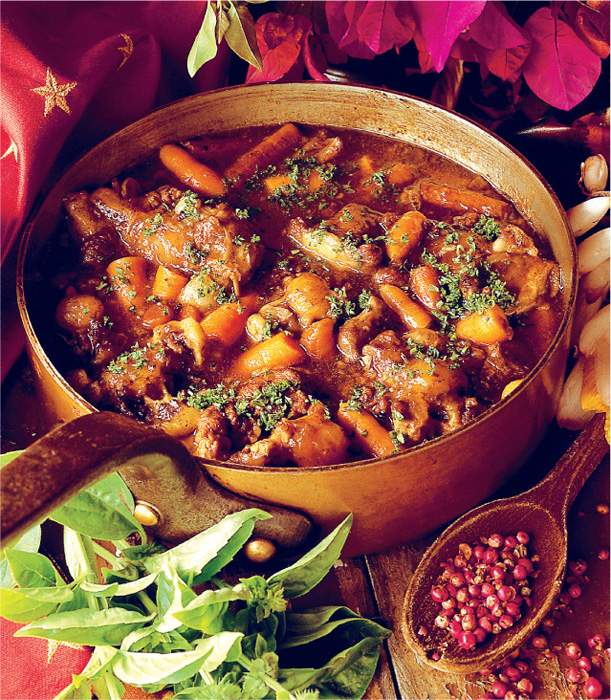
Oxtail Stew makes a mouthwatering meal, especially in the heart of winter.
- 1.5 kg oxtail, trimmed and cut into joints
- 1 clove garlic, crushed
- 500 ml Meat (Beef) Stock (page 11)
- 1 bay leaf
- 4 whole cloves
- 5 peppercorns
- 5 ml salt
- 5 ml milled pepper
- 1 medium onion, sliced, or 10 pickling onions, peeled
- 8–10 young carrots
- Place the meat, garlic, 250 ml of the stock, the bay leaf, cloves, peppercorns, salt and pepper in a heavy-based saucepan. Simmer, covered, over moderate heat for 3–4 hours, adding more boiling stock as needed. After 2 hours of cooking, add the onion and carrots. Remove the cloves and bay leaf, and skim off the fat before serving with boiled or mashed potatoes.
- NOTE Oxtail stew is perfect for cooking in a potjie over the coals.
Serves 4–6
BRAISED LIVER WITH ONIONS
Offal is an important part of the Malay menu, and they often serve liver braised with onions. The secret of tender braised liver is to cut it thinly and cook it quickly.
- 65 ml sunflower oil
- 750 g calf’s liver, skinned and thinly sliced
- 3 medium onions, sliced
- salt and milled pepper
- 45–60 ml Meat (Beef) Stock (page 11) or water
- Heat a little of the oil and fry the liver quickly on both sides. Set the liver aside and keep it warm. Heat the rest of the oil in the pan and sauté the onions for about 5 minutes, or until transparent. Season lightly with salt and pepper and add the stock or water to the pan. Cook, uncovered, over high heat until slightly reduced, then return the liver to the pan and heat through for 5–10 minutes over moderate heat. Serve immediately with mashed potatoes.
Serves 6
BILTONG
Biltong (savoury dried meat) has been around for centuries; for instance, a more primitive form, the Dutch tassal, was also prepared in certain areas of France during the late Middle Ages. Tassal was also made in Batavia, and made its way to South Africa with the Dutch settlers, where it was adapted to the less pungent biltong. Most farmers have a special rack where they hang the biltong to dry.
- 12.5 kg venison, beef or ostrich meat (fillet, rump or sirloin)
- 560 g fine salt
- 125 ml brown sugar
- 25 ml bircarbonate of soda
- 10 ml saltpetre (optional)
- 12.5 ml milled pepper
- 125 ml coarsely ground coriander
- 250 ml brown vinegar
- 2.5 litres warm water
- Cut the meat along the natural dividing lines of the muscles down the length of the whole leg, or a portion of it. Cut the pieces into strips 5–7 cm thick, with some fat on each strip. Mix the salt, sugar, bicarbonate of soda (this makes the biltong tender), saltpetre, pepper and coriander together, and rub the mixture into the strips of meat. Layer the meat – with the more bulky pieces at the bottom – in a wooden, earthenware, plastic or enamel container and sprinkle a little vinegar over each layer. Leave the meat in a cool place for about 1–2 days, depending on how thick the meat is and how salty you want it to be. Mix the vinegar and water and dip the biltong into it (this makes it shiny and dark). Pat the pieces of meat dry and hang them on S-shaped hooks – or use pieces of string – about 5 cm apart (so that the air can circulate freely among the strips of meat) in a cool, airy place. Leave for 2–3 weeks until the biltong is dry.
Makes about 10 kg
DRIED SAUSAGE (DROËWORS)
- 3 kg beef
- 20 ml salt
- 2 ml pepper
- 50 ml ground roasted coriander
- 2 ml ground allspice
- 2 ml ground cloves
- 500g mutton tail fat
- 25 ml brown vinegar
- 85 g sausage casings
- Season the meat with the salt, pepper and spices. Mince all the ingredients (except the casings) together coarsely. Press the mixture loosely into the casings and hang the sausage up to dry in a cold, dry place, ensuring that it is protected from flies and dust. Leave to dry for 2–3 weeks.
Makes about 2.5 kg
SALTED RIB (SOUTRIBBETJIE)
Ribs, given a similar treatment to biltong, are really delicious braaied over the coals.
- 20 ml brown sugar
- 250 ml coarse salt
- 2 ml saltpetre
- 10 ml ground coriander
- 5 ml ground cloves
- 20 ml brown vinegar
- 2 kg flat rib or breast of lamb
- Combine the sugar, salt, saltpetre, coriander, cloves and vinegar. Rub well into the meat. Place the meat in a plastic, glass or earthenware container and refrigerate for 2 days. Remove the rib and hang it in a cool, airy place to dry. Grill or braai the rib for 30 minutes, turning often, or until done to taste.
Dried meat
Salting or pickling (curing) meat was the traditional means of preserving it before there were refrigerators and freezers in which to store the food. Each of the ingredients used for preserving had a special role to play: salt preserved the meat, saltpetre imparted the colour and prevented decay, sugar kept the meat from drying out too much and spices added flavour.
Serves 6
HOME-MADE BOEREWORS
Our self-sufficient farming community wasted nothing. When a beast was slaughtered in winter, all parts were used, including the trotters, which were used for making Brawn (page 59), and the intestines, which were used as casings for home-made sausage. Every farmer’s wife prided herself on her own special recipe for making sausage. The fillings ranged from beef and mutton to game meat or even game offal encased in game intestines and called Skilpad and Pofadder (page 67).
- 1.5 kg beef
- 1.5 kg pork
- 500 g speck, diced
- 25 ml salt
- 5 ml milled pepper
- 50 ml ground coriander
- 2 ml freshly grated nutmeg
- 1 ml ground cloves
- 2 ml ground dried thyme
- 2 ml ground allspice
- 125 ml brown vinegar
- 1 clove garlic, crushed
- 50 ml Worcestershire sauce
- 85 g sausage casings
- Mince or process the meat coarsely, then mix it with all the other ingredients, except the sausage casings. Fill the sausage casings firmly but not too tightly with the meat mixture, making sure that the speck is distributed evenly throughout the sausage. Boerewors can be fried, grilled or braaied over the coals. It will keep in the refrigerator for 1–2 days and in the freezer for up to 3 months.
- VARIATIONS Use veal, lamb or venison instead of beef.
Makes 3.5 kg
TRIPE AND TROTTERS (PENS-EN-POOTJIES)
This dish is part of many a culinary culture, including that of the Malay community. Another popular way to cook tripe is in buttermilk, which tenderizes the tripe.
- 4 sheep’s trotters, cleaned and chopped
- 1 sheep’s tripe, cleaned
- salted water
- 25 ml brown vinegar
- 5 ml white sugar
- 2 whole cloves
- 10 ml peppercorns
- 5 ml coriander seeds
- 5 ml allspice berries
- 1 bay leaf
- 10 ml salt
- 2 ml milled pepper
- 1 large onion, sliced
- 15 ml curry powder
- 10 ml turmeric
- 500 g small potatoes
- Soak the trotters and tripe in enough salted water to cover for 1 hour. Drain. Boil each separately in enough fresh cold water to cover for about 1 hour, or until soft. Drain, reserving the liquid from the trotters. Dice the meat, add the reserved liquid and all the other ingredients and simmer, covered, for about45 minutes. Serve with boiled rice.
Serves 6
SAMOOSAS
Samoosas were introduced to South Africa by Indian immigrants, and have also been adopted by the Malay community and become a favourite snack of most South Africans. The pastry triangles can have a filling of meat or vegetables.
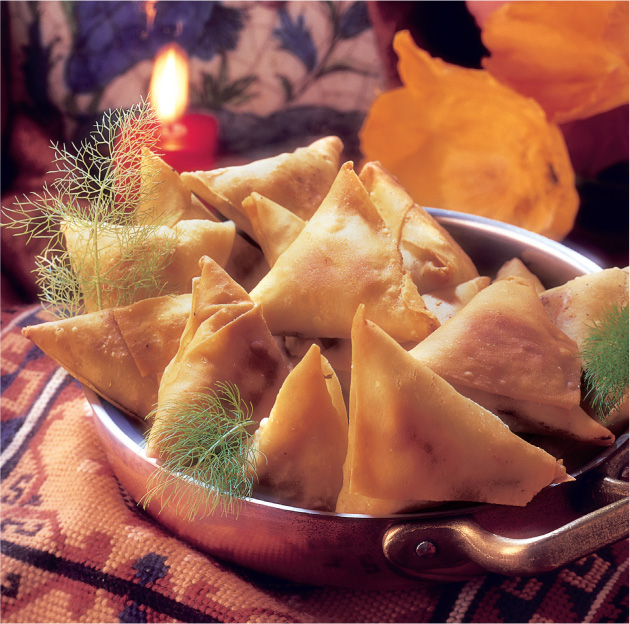
Samoosas are a favourite among many South Africans.
DOUGH
- 375 g cake flour
- 5 ml salt
- 250 ml cold water
- 5 ml lemon juice
- 15 ml melted butter or sunflower oil
FILLING
- 500 g mutton or lamb, minced
- 2 ml turmeric
- 5 ml salt
- 1 large clove garlic
- 1 piece root ginger
- 10 ml finely chopped coriander leaves
- 1 green chilli, crushed
- 2 medium onions, finely chopped
- 15 ml melted butter
- 4 spring onions, finely chopped
- 2 ml garam masala
- sunflower oil
- To make the dough, sift the flour and salt together and add enough cold water to make a stiff dough. Add the lemon juice and knead the dough gently until elastic. Divide the dough into 12 pieces and roll each into a ball. Roll out 6 balls on a floured surface and shape them into 10-cm diameter rounds. Brush each with melted butter or oil and sprinkle with flour. Stack the rounds, leaving the final round ungreased and unfloured. Roll out the stack into a large, very thin round and trim the sides to form a square. Heat an ungreased baking sheet in the oven at 230 °C until very hot, remove and place the dough square on it. Turn the square over several time until the dough puffs up slightly. Remove the square from the baking sheet as soon as this happens. Repeat for the remaining 6 balls of dough.
To make the filling, cook the meat with a mixture of the turmeric, salt, garlic and ginger pounded together, the coriander leaves and the chillies. When nearly dry, add the onions and cook until the liquid has evaporated, stirring often to prevent lumps forming. Add the melted butter, allow the mixture to cool and add the spring onions and garam masala.
To assemble, cut the prepared dough squares into strips 8 cm wide and 25–30 cm long. Separate into layers before the pastry cools. (Cover the strips with a damp cloth to prevent drying out while making the samoosas.) Holding a strip of pastry in your left hand, pull the bottom corner across, then fold it up to form a triangle with sharp corners and a pocket in which to put the filling. Fill with 10 ml filling, then continue folding the pastry across the top of the triangle to seal off the opening. Tuck the edges round to form a neat triangle. Seal the remaining edge with a paste of flour and water, and pinch the two bottom edges lightly together. Leave in a cool place for about 30 minutes before cooking.
Fry the samoosas in hot oil for about 10 minutes, or until they are golden, turning often. Remove and drain in a colander or on absorbent paper.
Serves 6–8
SMOKING MEAT
Our farming ancestors used to smoke meat in special smoke-houses. Today, there’s a much quicker method, called smoke roasting, which does not require the meat to be soaked in brine beforehand. Smoking may also be done over hot coals, in a commercial smoker or in a closed braai like the Weber braai.
YOU WILL NEED
- A heavy-based saucepan with a tight-fitting lid.
- A trivet or pot stand that will fit inside the saucepan (this allows air to circulate all round the food to be smoked).
- A metal container for the food, which fits inside the saucepan but still allows air to circulate freely. A foil dish is the easiest alternative.
- Untreated hardwood shavings – oak is generally best – available from hardware stores. Use only 30 ml per saucepan, otherwise the meat will be bitter.
HERE’S HOW TO SMOKE MEAT
- Sprinkle wood shavings in the base of the saucepan and place the trivet in the saucepan.
- Brush the meat with oil and season as desired.
- Place the meat on the foil plate and position the plate on the trivet in the saucepan.
- Close the saucepan tightly – if the lid doesn’t seal properly, place aluminium foil over the saucepan and jam the lid on.
- Cook (smoke) the meat on top of the stove, on high, for 15 minutes, then reduce the temperature to low and smoke the meat for an additional 30 minutes for rare beef fillet, or 1 hour for pork, lamb or medium to well-done beef fillet.
- Some smoked meats, like beef, require additional curing. To do this, wrap the meat in foil and, when cooled, refrigerate for 24 hours.
- Smoke boerewors for 15 minutes on high, and 15 minutes on low. Serve hot or cold.
- Pork and lamb may be used right after smoking, or cured for a further 24 hours and served cold.
- Meat can be smoked until completely done, or smoked until half done and then roasted.
STEAK AND KIDNEY PIE
FILLING
- 25 ml sunflower oil
- 750 g stewing steak, cubed
- 2 lamb’s kidneys, cleaned and diced
- 1 large onion, chopped
- 250 ml Meat (Beef) Stock (page 11)
- 5 ml salt
- 2 ml milled pepper
- 25 ml cake flour
- To make the filling, heat the oil in a frying pan and brown the steak and kidneys on all sides. Add the onion and sauté for about 5 minutes, or until the onion is transparent. Add the stock, salt and pepper and simmer, covered, for 11⁄2–2 hours. Mix the flour to a paste with a little water and use to thicken the gravy. Spoon the mixture into a deep pie dish and leave it to cool slightly. Roll the pastry out and use to cover the meat, crimping the edges to the rim of the pie dish. Cut slits in the top of the crust to allow steam to escape during the cooking and bake the pie at 200 °C for 15 minutes.
Serves 6
SAVOURY TART (SOUTTERT)
In many South African homes, no family gathering would be complete without a delectable savoury tart – and, of course, a melktert (see Milk Tart, page 101).
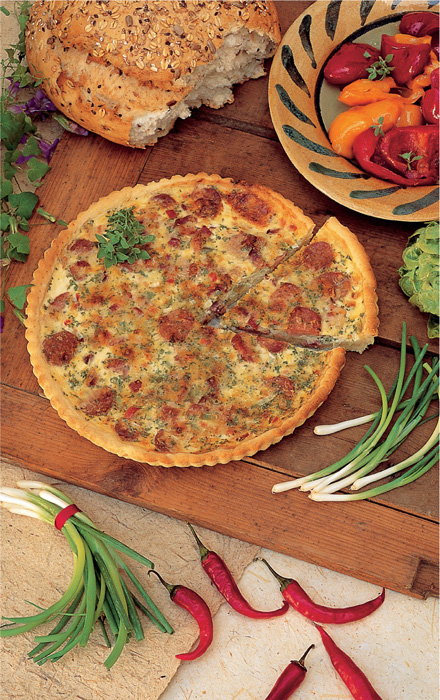
Savoury Tart is a firm favourite at family gatherings.
FILLING
- 30 ml cornflour
- 500 ml milk
- 4 large eggs, beaten
- 3 rashers rindless bacon, chopped
- 2 slices ham, cubed
- 5 slices salami, smoked sausage or chopped Vienna sausages
- 30 ml finely chopped onion
- 30 ml finely chopped fresh parsley
- 250 ml grated Cheddar cheese
- 30 ml seeded and chopped green pepper
- Line a large pie dish with the pastry. To make the filling, combine the cornflour and the milk, then stir in the remaining ingredients, mixing well. Pour the filling into the pastry shell and bake the tart at 180 °C for 25 minutes, or until the pastry is golden and the filling has set. Serve hot.
Serves 6–8
LAMB PIE (RUGSTRINGPASTEI)
FILLING
- 25 ml sunflower oil
- 1 onion, sliced
- 1 kg stewing lamb or chine, cubed
- 8 whole cloves
- 1 bay leaf
- 10 ml salt
- 250 ml water
- 2 rashers bacon, chopped
- 5 ml chopped fresh rosemary
- 25 ml cake flour
- 2 hard-boiled eggs, shelled and sliced
- To make the filling, heat the oil in a frying pan and sauté the onion for about 5 minutes, or until transparent. Add the meat and brown quickly on all sides. Add the cloves, bay leaf, salt and water, and stew the meat for about 1 hour, or until very soft. Remove the meat from the bones, if desired. Roll out half the Puff Pastry and use it to line a pie dish. Add the bacon, rosemary and flour to the meat. Spoon the meat mixture into the pie dish and arrange the egg slices on top. Roll out the remaining pastry and cover the meat with it, crimping the pastry edges together. Cut slits in the crust to allow steam to escape during cooking and bake at 230 °C for 10 minutes. Reduce the heat to 180 °C and bake for a further 20–30 minutes.
Serves 6
CURRIED MINCE PIES
In the days before refrigeration, curry was often used to make meat last longer. These pies are a perfect example.
- 350 g Flaky or Shortcrust Pastry (page 100), without sugar
FILLING
- 1 slice white bread
- 50 ml milk
- 1⁄2 medium onion, finely chopped
- 15 ml sunflower oil
- 10 ml medium-strength curry powder
- 500 g minced lean beef
- 5 ml chutney
- 5 ml salt
- milled black pepper
- 10 ml lemon juice or brown vinegar
- 1 large egg, beaten
- To make the filling, soak the bread in the milk. Sauté the onion in heated oil for 5 minutes, or until the onion is transparent. Add the curry powder and fry for a few minutes. Add the meat and chutney and cook for 5 minutes, or until the meat is browned. Add the remaining seasoning and simmer for another 5 minutes. Allow the mixture to cool, then mix it with the soaked bread. Roll out the pastry and cut out 24 rounds with a biscuit cutter. Place spoonfuls of filling in the centre of 12 rounds and brush the edges of the pastry with cold water. Cover each round with a second round and press the edges together with a fork. Prick the top crust to allow steam to escape during baking. Brush with beaten egg and place the pies on a baking sheet. Bake at 200 °C for 20 minutes, or until the pastry is golden. Serve hot.
Makes about 12
TRADITIONAL BRAWN
Brawn was part of the Christmas fare in Europe during the Middle Ages. It was made from wild boar, and ale or wine was often part of the recipe. Early settlers in South Africa continued the tradition, substituting the locally available meat for the more exotic boar. All the scraps of meat left over when an animal was slaughtered went into the brawn, so nothing was wasted.
- 12 sheep’s trotters
- 125 g lime dissolved in 9 litres boiling water
- 4 whole cloves
- 12 allspice berries
- 12 black peppercorns
- 15 ml coriander seeds
- 4 bay leaves
- 250 ml brown vinegar
- 10 ml salt
- Dip the trotters in the lime water and scrape them clean. Soak them in salted water to cover for 1 hour. Drain and chop the trotters into small pieces. Cover with fresh water and simmer over low heat until the meat is tender. Remove the bones. Tie the cloves, allspice berries, peppercorns, coriander seeds and bay leaves in a muslin bag and add to the saucepan. Add the vinegar and salt and simmer, covered, for 1 hour. Remove the bag of spices. Spray a mould or glass dish with non-stick cooking spray and pour in the mixture. Chill until set and serve cold. Brawn will keep for about 1 week if refrigerated. Do not freeze, as the texture of the jelly is spoilt by freezing and thawing.
Serves 10

